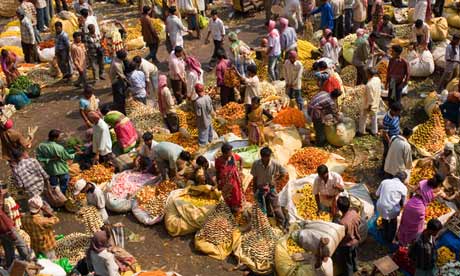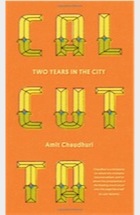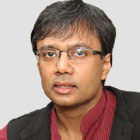To a young Amit Chaudhuri, Calcutta seemed its own strange, particular world – and thrillingly modern. Later, it lagged behind as India underwent vast change, but now it can resist no more

Fulfilling a childhood fantasy … Chaudhuri
moved to Calcutta, later Kolkata, in 1999. Photograph: Peter
Dench/Alamy
I was in Berlin at the
end of 2005 when my agent called and asked me if I'd write a book on Calcutta.
It was a work of non-fiction he wanted: Indian non-fiction was going to be the
new Indian fiction. I declined, saying, "I'd rather write about Berlin"; but I
saw where he was coming from. Suketu Mehta's compendious narrative of Bombay
low-life, Maximum
City, had been a critical and commercial success. It wouldn't have
taken much to guess that it, and a country transformed by 15 years of economic
deregulation, would unleash a stream of books on what, in journalistic
shorthand, is called the "new India". I'd written three
novels which had Calcutta as their setting, and my agent probably saw me as the
ideal candidate for producing a non-fiction work on the city. The mid-2000s was
a time of complete immersion in the present – a characteristic of free-market
capitalism – so that things that had happened 15, 10, or even five years ago
felt remote, and the frequent "all-time best" lists in newspapers covered a span
of, at most, 20 years. From the perspective of this compressed view of eternity,
my novels about Calcutta might almost have inhabited another era. Perhaps it was
time to write a new book about the city.
 I instinctively knew that
I couldn't, and didn't want to, do a Maximum City with Calcutta.
Mehta's book, which I
had reviewed and admired, wasn't just about Bombay; it was a creation-myth
for a new nation and its unprecedented, amoral provenance. History may not have
ended, but the Nehruvian era had, with its "mixed" economy of socialist
development, Five-Year Plans, idealistic hypocrisies and circumscribed private
enterprise. Dams, the avowed temples of the older, industrialising nation, had
given way to new temples where the rich and the aspirational classes could
congregate in a kind of celebration, such as international airports (Katherine
Boo's recent book, Behind
the Beautiful Forevers, records the doomed theatre of a slum that
festers, hidden, behind Bombay's Chhatrapati Shivaji International Airport).
I instinctively knew that
I couldn't, and didn't want to, do a Maximum City with Calcutta.
Mehta's book, which I
had reviewed and admired, wasn't just about Bombay; it was a creation-myth
for a new nation and its unprecedented, amoral provenance. History may not have
ended, but the Nehruvian era had, with its "mixed" economy of socialist
development, Five-Year Plans, idealistic hypocrisies and circumscribed private
enterprise. Dams, the avowed temples of the older, industrialising nation, had
given way to new temples where the rich and the aspirational classes could
congregate in a kind of celebration, such as international airports (Katherine
Boo's recent book, Behind
the Beautiful Forevers, records the doomed theatre of a slum that
festers, hidden, behind Bombay's Chhatrapati Shivaji International Airport).Full article

No comments:
Post a Comment